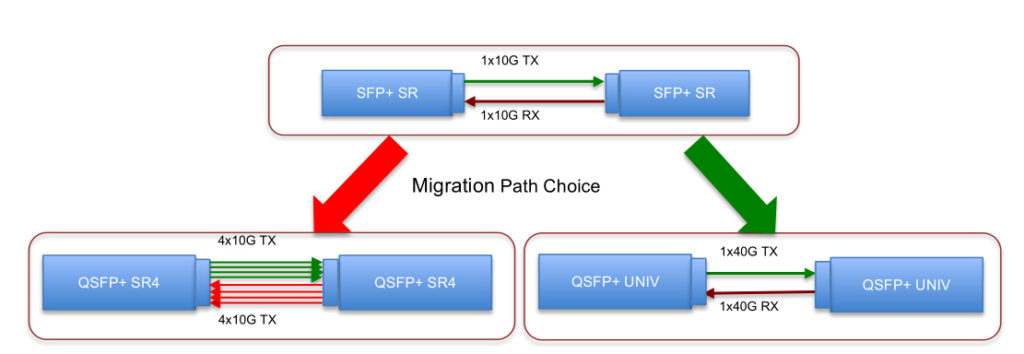When choosing 40G transceiver for upgrading your system, you may always find various transceivers that satisfy your needs. For instance, 40G-QSFP-SR4-INT, QFX-QSFP-40G-SR4 are widely applied for 40G short distance transmission and QSFP-40GE-LR4, QSFP-40G-LRL4 for 40G long distance transmission. However, have you ever heard the description for 40G transceiver like QSFP-40G-UNIV? Are you familiar with this 40GBASE module? What’s the difference in contrast to other 40GBASE modules? Why and how it is used? What will data center benefit from it? Let’s talk about the knowledge of QSFP-40G-UNIV and explore the related questions mentioned above.
QSFP-40G-UNIV transceiver is a pluggable optical transceiver designed with a duplex LC connector and four 10G multiplexed channels to transmit and receive an aggregate 40G signal, achieving 40G data transmission through a single pair of single-mode or multimode fiber. As an ideal solution for data center upgrade, it allows for a very cost-effective migration from 10G to 40G with minimal disruption.
Compared to other 40GBASE modules that are only able to work through one type of the fiber patch cable, QSFP-40G-UNIV transceiver can universally work on both single-mode and multimode fiber patch cable, just like its name “UNIV” implies. For this reason, it is also known as SMF&MMF 40G transceiver or QSFP 40G universal transceiver. As for the transmission distance that QSFP-40G-UNIV transceiver supports, it could be up to 150 meters over OM3/OM4 and 2 kilometers over SMF for 40G data transmission.
The demand for 40G connections in the data center is growing day by day to accommodate the server consolidation, virtualization, and performance improvements, which brings a big challenge to 40G transceivers. Under this circumstance, QSFP-40G-UNIV transceiver was published and came into market, which makes a great difference in the 40G migration.
As we know, various transceivers are available in the present market for short distance applications, most of which work with MPO-12 connectors and ribbon fiber infrastructures. Hence, if you want to upgrade your system from 10G to 40G, you have to add new fibers for your system or deploy MTP/MPO fiber systems on which you may spend lots of money. To address the problem, QSFP-40G-UNIV transceiver with LC connector has the ability to support several types of cables, which facilitates the migration from 10G to 40G network without redesign or expansion of the existing fiber network. Meanwhile, it is optically interoperable with QSFP-40GE-LR4, QSFP-40G-LRL4 for easy connection to router and switch in existing fiber network, thereby a big convenience can be also provided to achieve 40G long distance applications. What’s more, it offers a transition path between single-mode and multimode modules with lower cost and supports all QSFP+ ports on switches without restrictions.
Are you curious about the working principle of QSFP-40G-UNIV transceiver, which is capable of carrying 40G signals over a duplex fiber cable? After all, the traditional 40G transceiver, like QSFP-40G-SR4, has to work through eight fiber cable. And each cable is used for transmitting or receiving 10G signal to finish the whole 40G link, as shown in the following figure.

From the figure, we can learn that selecting QSFP-40G-SR4 transceiver to achieve 40G connection requires four times more fibers than choosing SFP-10G-SR transceiver to support 10G connection. However, using QSFP-40G-UNIV transceiver allows the 40G connection to be operated over the same duplex fiber infrastructure as SFP-10G-SR transceiver. In its working process, there are four transmitters that convert four 10G electrical signals into four 10G light signals. Then the four 10G light signals are multiplexed as a 40G signal, transmitted through the duplex fiber patch cable, and de-multiplexed into four individual 10G light signals again. Finally, the four light signals will pass through each receiver and be converted into electrical signals.
Compared to traditional 40G transceivers, QSFP-40G-UNIV transceiver is an ideal solution for smooth migration from 10G to 40G without redesign or change of the existing fiber network, which is suitable for both short and long data transmission. Besides, it allows for the transition between multimode and single-mode modules, as a very cost-effective connectivity solution. Hence, if the cabling infrastructure of your network is very complicated, QSFP-40G-UNIV transceiver is highly recommended for you to achieve an easy, fast and smooth migration from 10G to 40G.









